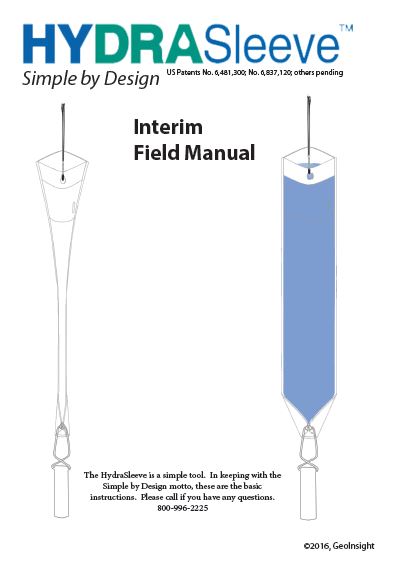We are in the process of updating our field manual. There are some new tips and guidelines included in the update. We recommend that all HydraSleeve users review the newest version available now by clicking on this image:
We have learned a lot since our first HydraSleeves were installed in 2002.
The Interim Field Manual covers the basics of installation, retrieval and dispensing. Soon we will be adding some important tips to remember. From our vast experience using HydraSleeves these tips can be valuable to the new (and even experienced) HydraSleeve users. For example:
1. To achieve a 1:1 fill rate using a continuous pull, you must size the HydraSleeve to fit the well diameter. Use 2-inch sleeves in 2-inch wells and 4-inch sleeves should be used in 4-inch wells. Recover through the sample zone at a rate of at least 1 foot per second. If in doubt, don't be afaid to cycle the sampler up and down within the well screen to assure that it fills in the screened interval. When cycling make sure the upstroke is at a minimum of 1 foot per second.
2. When recovered using continuous upward pull the HydraSleeve collects a sequential core of sample. The lower-most portion of the sample interval will be in the bottom of the sleeve and the upper-most portion in the top of the sleeve.
3. Always discard the water sitting on top of the check valve prior to puncturing the bag to discharge the sample. If the bag is punctured without discarding the liquid from the top of the check valve, the non-represenative fluid above the valve will drain into the sample.
4. For sensitive, low volume VOC samples (sinkers) it is better to puncture the HydraSleeve in the middle or lower half of the unit to provide a sample collected from the bottom of the sample zone.
5. If in doubt, cycle the HydraSleeve to be sure if fills in the well screen. Studies have shown that cycling has minimal effect on sample turbidity.
6. Bottom-weighted HydraSleeves displace very little fluid when they are deployed which results in minimal mixing of the water column. When modified slightly (ie. SpeedBag) they can eliminate the well equilibration period normally required for no-purge samples.
7. Recover the HydraSleeve rapidly through the sceened interval then try to recover at slightly slower but steady pace through the casing.
These are the kinds of practical tips that come from more than a decade of experience in working with HydraSleeves. Please review the interim field manual for basic guidelines; but please do not hesitate to contact us if you have any questions about using HydraSleeves for your specific application. 800-996-2225 or This email address is being protected from spambots. You need JavaScript enabled to view it.
Please remember the HydraSleeve is a simple tool - so is a screwdriver. Both can be misused.

